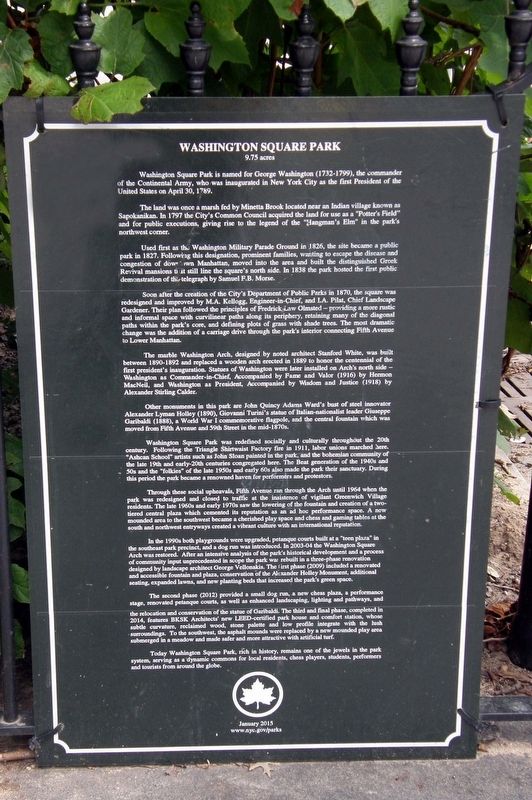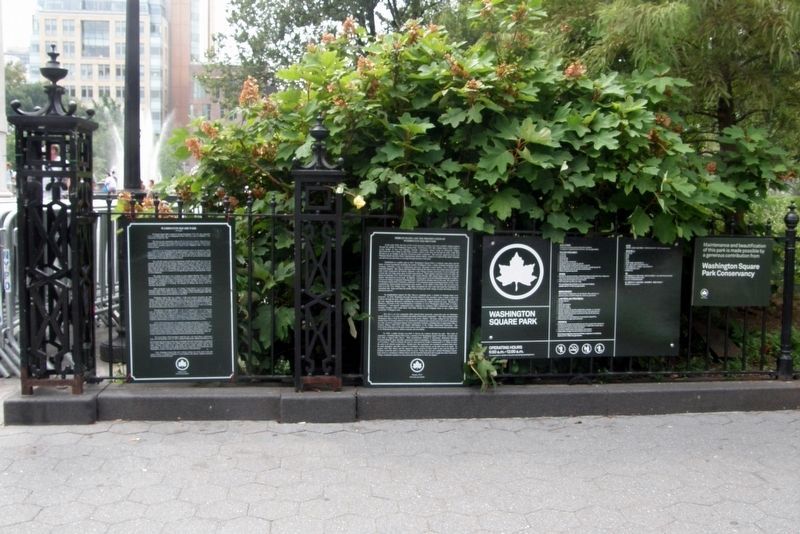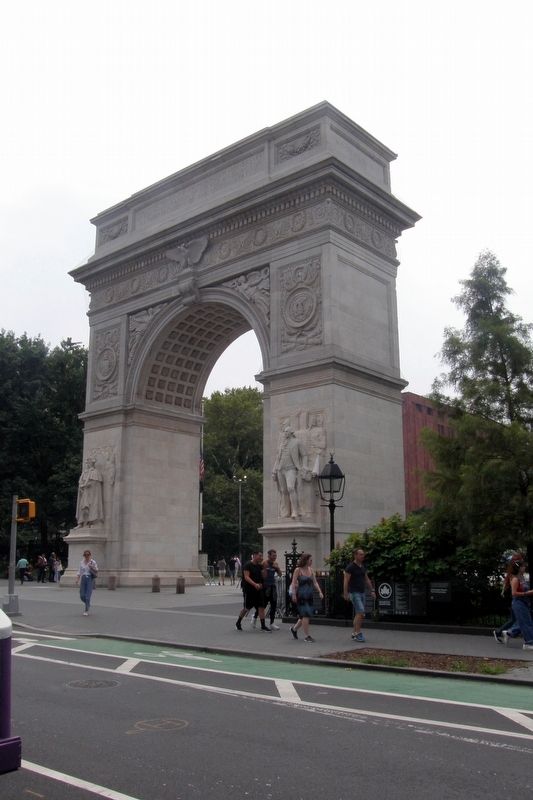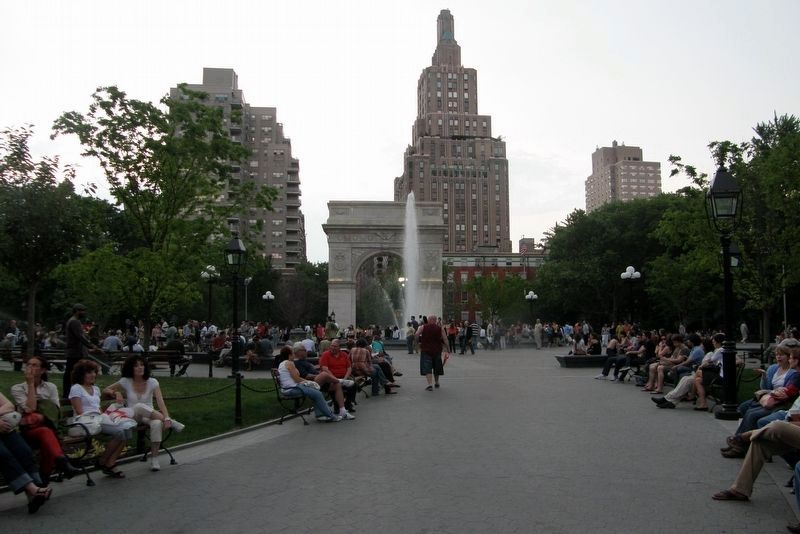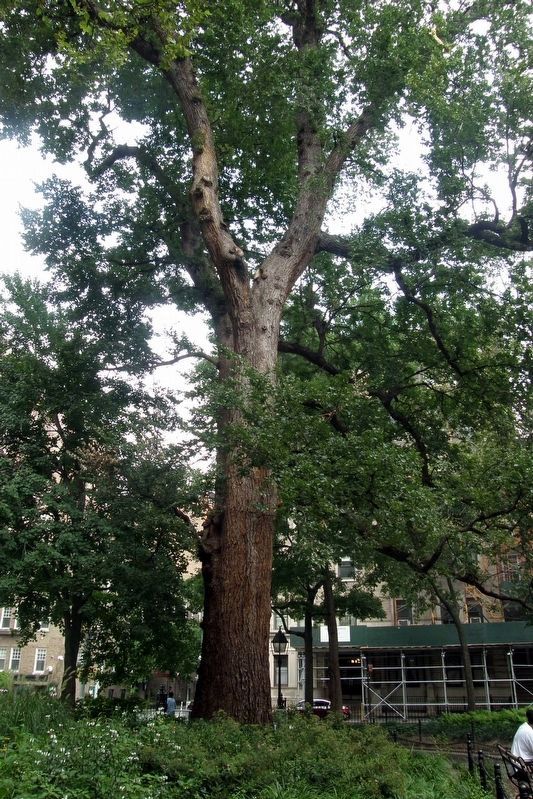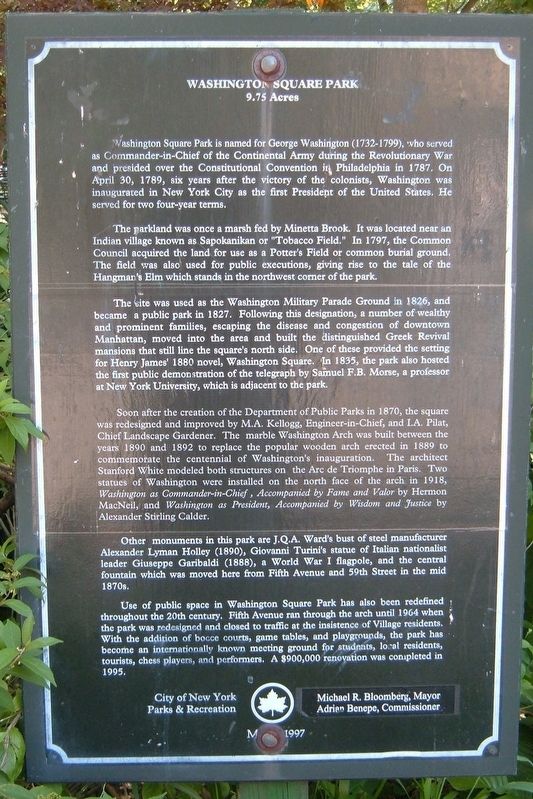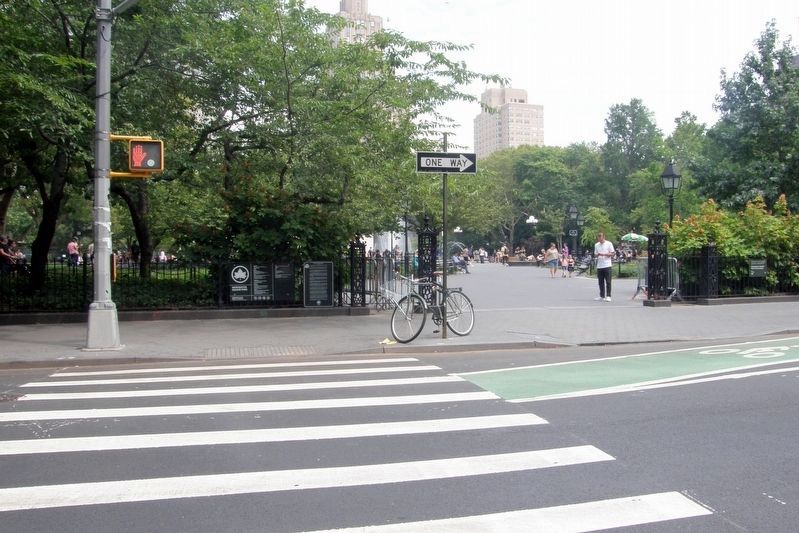Greenwich Village in Manhattan in New York County, New York — The American Northeast (Mid-Atlantic)
Washington Square Park
9.75 acres
The parkland was once a marsh fed by Minetta Brook, located near an Indian village known as Sapokanikan or “Tobacco Field.” In 1797, the Common Council acquired the land for uses as a Potter’s Field and for public executions, giving rise to the legend of the Hangman’s Elm which stands in the northwest corner of the park.
First used as the Washington Military Parade Ground in 1826, the site became a public park in 1827. Following this designation, a number of wealthy and prominent families, wanting to escape the disease and congestion of downtown Manhattan, moved into the area and built the distinguished Greek Revival mansions that still line the square’s north side. In 1838 the park hosted the first public demonstration of the telegraph by Samuel F.B. Morse.
Soon after the creation of the Department of Public Parks in 1870, the square was redesigned and improved by M.A. Kellogg, Engineer-in-Chief, and I.A. Pilat, Chief Landscape Gardener. Their plan followed the principles of Frederick Law Olmsted – providing a more rustic and informal space with curvilinear paths along its periphery, retaining many of the diagonal paths within the park’s core, and defining plots of grass with shade trees. The most dramatic change was the addition of a carriage drive through the park’s interior connecting Fifth Avenue to Lower Manhattan.
The marble Washington Arch, designed by noted architect Stanford White, was built between 1890-1892 and replaced a wooden arch erected in 1889 to commemorate the centennial of the first president’s inauguration. Statues of Washington were later installed on (sic) Arch’s north side - Washington as Commander-in-Chief, accompanied by Fame and Valor (1916) by Hermon MacNeil, and Washington as President, accompanied by Wisdom and Justice (1918) by Alexander Sterling Calder.
Other monuments in this park are John Quincy Adams Ward’s bust of steel innovator Alexander Lyman Holley (1890), Giovanni Turini’s statue of Italian-nationalist leader Giuseppe Garibaldi (1888), a World War I flagpole, and the central fountain which was moved here from Fifth Avenue and 59th Street in the mid-1870s.
Washington Square Park was redefined socially and culturally throughout the 20th century. Following the Triangle Shirtwaist Fire in 1911, labor unions marched here. “Ashcan School” artists such as John Sloan painted in the park, and the bohemian community of the late 19th and early-20th centuries congregated here. Th Beat generation of the
1940s and 50s and the “folkies” of the 1950s and early 60s also made the park their sanctuary. During this period the park became a haven for performers and protesters.
Through these social upheavals, Fifth Avenue ran through the Arch until 1964 when the park was redesigned and closed to traffic at the insistence of vigilant Greenwich Village residents. The late 1960s and early 1970s saw the lowering of the fountain and creation of a two-tiered central plaza which cemented its reputation as an ad hoc performance space. A new mounded area to the southwest became a cherished play space and chess and gaming tables at the south and northwest entryways created a vibrant culture with an international reputation.
In the 1990s both playgrounds were upgraded, petanque courts built a “teen plaza” in the southwest park precinct, and a dog run was introduced. In 2003-04 the Washington Square Arch was restored. After an intensive analysis of the park’s historical development and a process of community input unprecedented in scope the park was rebuilt in a three-phase renovation designed by landscape architect George Vellonakis. The first phase (2009) included a renovated and accessible fountain and plaza, conservation of the Alexander Holley Monument, additional seating, expanded lawns, and new planting beds that increased the park’s green space.
The
second phase (2012) provided a small dog run, a new chess plaza, a performance stage, features BKSK Architects’ new LEED-certified park house and comfort stations, whose subtle curvature, reclaimed wood, stone palette and low profile integrate with the lush surroundings. To the southwest, the asphalt mounds were replaced by a new mounded play area submerged in a meadow and made safer and more attractive with artificial turf.
Today Washington Square Park, rich in history, remains one of the jewels in the park system, serving as a dynamic commons for local residents, chess players, students, performers and tourists from around the globe.
Erected 2015 by NYC Parks.
Topics. This historical marker is listed in these topic lists: Parks & Recreational Areas • Patriots & Patriotism. A significant historical month for this entry is March 1997.
Location. 40° 43.887′ N, 73° 59.829′ W. Marker is in Manhattan, New York, in New York County. It is in Greenwich Village. Marker is at the intersection of Washington Square North and Fifth Avenue, on the left when traveling west on Washington Square North. Touch for map. Marker is in this post office area: New York NY 10003, United States of America. Touch for directions.
Other nearby markers. At least 8 other markers are within walking distance of this marker. Shirley Hayes and the Preservation of Washington Square Park (here, next to this marker); Washington Arch (a few steps from this marker); Washington Square WWI Memorial (within shouting distance of this marker); Bella Abzug (within shouting distance of this marker); Edward I. Koch (within shouting distance of this marker); Alexander Lyman Holley (about 300 feet away, measured in a direct line); NYU 9/11 Memorial (about 300 feet away); Cervantes (about 300 feet away). Touch for a list and map of all markers in Manhattan.
More about this marker. A duplicate of this marker is at the Washington Square South and Thompson Street park entrance.
Also see . . . Washington Square Park. Official NYC Parks description. (Submitted on February 26, 2020, by Larry Gertner of New York, New York.)
Credits. This page was last revised on January 31, 2023. It was originally submitted on August 29, 2019, by Larry Gertner of New York, New York. This page has been viewed 300 times since then and 30 times this year. Photos: 1, 2, 3, 4, 5, 6. submitted on August 29, 2019, by Larry Gertner of New York, New York. 7. submitted on August 30, 2019, by Larry Gertner of New York, New York. • Bill Pfingsten was the editor who published this page.
